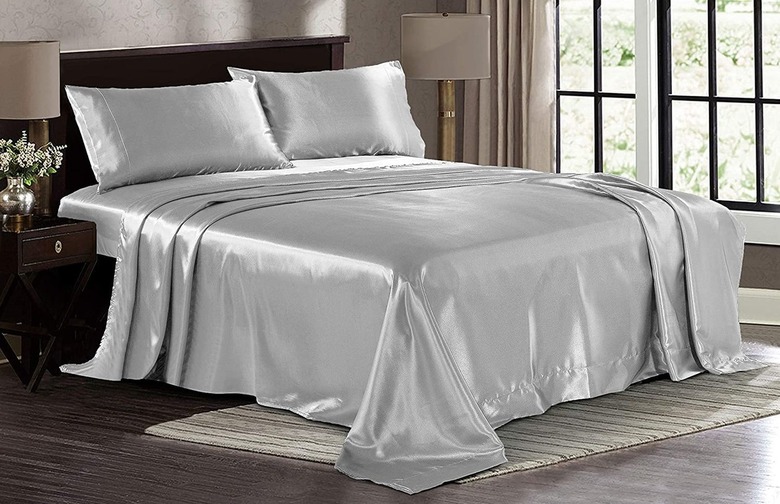Disadvantages Of Satin Sheets
We may receive a commission on purchases made from links.
Sleep is sacred, and a good night's rest often starts with comfy, cozy bedding. For those who get incredibly hot while sleeping or those looking to create a romantic ambiance in the bedroom, satin sheets become a go-to bedroom decor choice. However, before investing in satin sheets, there are a few key disadvantages to weigh before pulling the purchase trigger.
Cleaning Satin Sheets Can Be Tricky
Cleaning Satin Sheets Can Be Tricky
Satin sheets are harder to clean than other cotton, linen, or percale varieties. While individual sheet manufacturers will provide their own care instructions, generally speaking, satin sheets are best cleaned by hand and then air-dried. This can be particularly tricky depending on how much indoor and outdoor space you have available. You can try running sating sheets through the washing machine on the gentlest setting, but you do so running the risk of damage.
Whichever way you clean satin sheets, you should absolutely never wring them out, as harsh treatment like this can damage the sheet fibers. Neglecting to care for satin sheets as carefully as is preferable can lead to them losing their breathability over time. Since this breathability is a key reason most people invest in satin sheets in the first place, losing that is not ideal. So, if you can't commit to cleaning satin sheets the way they most benefit from being cleaned, switching to satin sheets may not be a worthwhile choice for you.
Satin Sheets Are Too Cold for Winter
Satin Sheets Are Too Cold for Winter
Satin sheets are typically quite cooling. This is because of the way their fibers are woven together for ultimate breathability. While this permeability is ideal for warmer summer months, in the winter, this cooling quality can be problematic. If you live in a particularly cool climate, satin sheets are not the ideal choice. However, keeping satin sheets handy for summer months and using cotton, linen, percale, flannel, or sateen sheets once the seasons change is always an option.
Style Choices Are Limited
Style Choices Are Limited
Due to the way satin sheets are woven together, they don't really lend themselves to patterning. Though patterned satin sheets do exist, due to the intricacy required in their production, those sheets can be incredibly expensive. For the most part, satin sheets are most often sold in solid colors.
These sheets also have a very particular shine to them that isn't always conducive to every decor aesthetic. If you are looking for sheets that are more matte or muted, exploring a fabric that can more easily accommodate that style, like cotton, could be a better direction to take stylistically.
Satin Sheets Can Be Expensive
Satin Sheets Can Be Expensive
Of all the sheet varieties available on the market today, satin sheets are some of the most complicated to manufacture. Satin as a fabric requires intricate fiber twisting and weaving work, which ultimately creates its shiny, silky surface. This involved manufacturing process translates to these sheets typically costing much more than simple cotton sheets. Satin sheets could run anywhere from $50 to $150 or more depending on the material and thread count, making them an investment. If you're looking for lower-cost sheets with a similar cooling feel, you might be better off with a percale sheet.
Overall, while satin sheets do have their advantages — being breathable, moisture-wicking, and accommodating to sensitive skin — they can also be expensive, inappropriate for winter temperatures, not universally conducive to all decorating aesthetics, and cumbersome to clean. Even so, is there anything more romantic than a silky satin sheet? Ultimately, no matter the pros and cons, the right sheet will always find its way into the right home.
